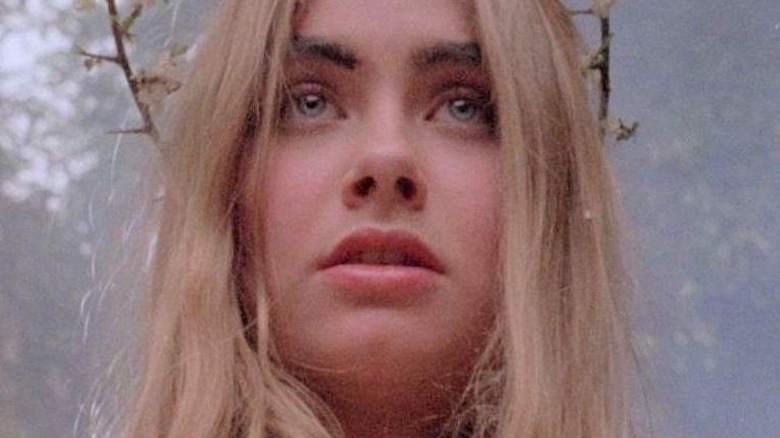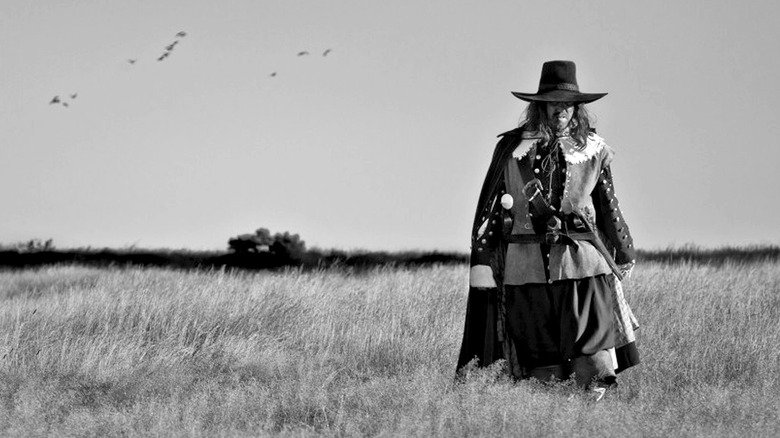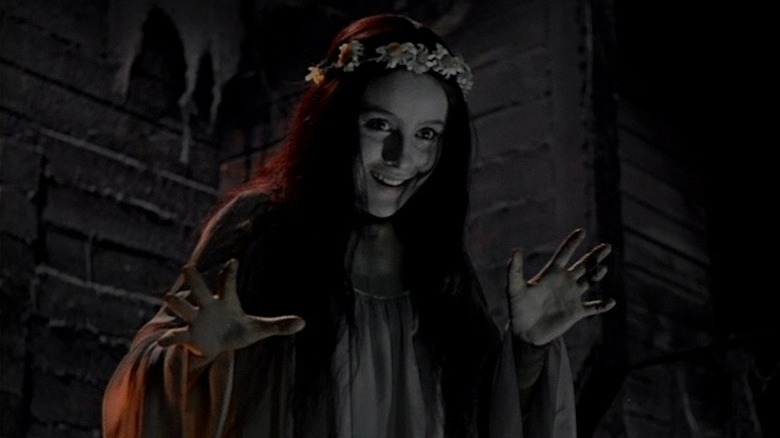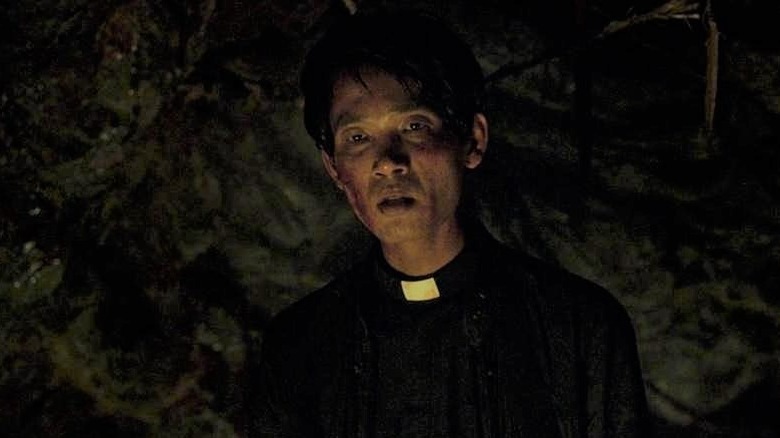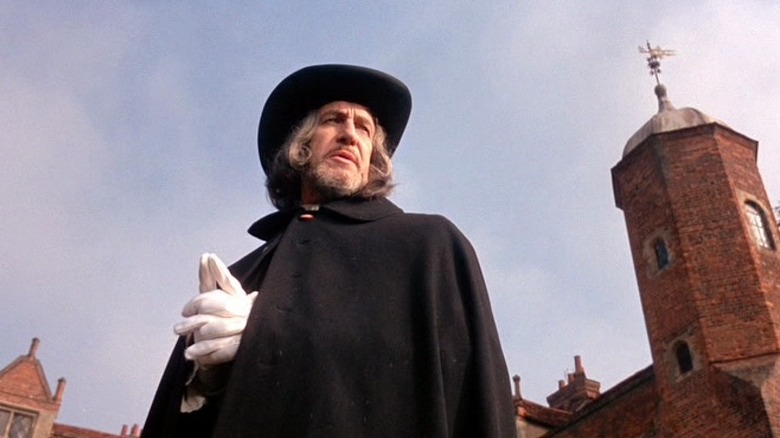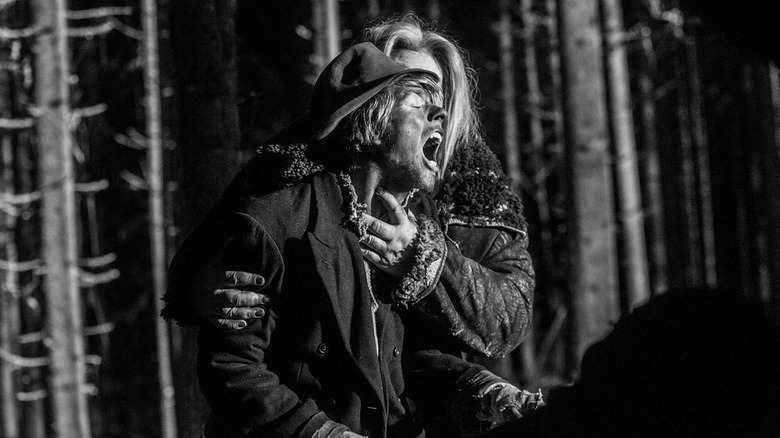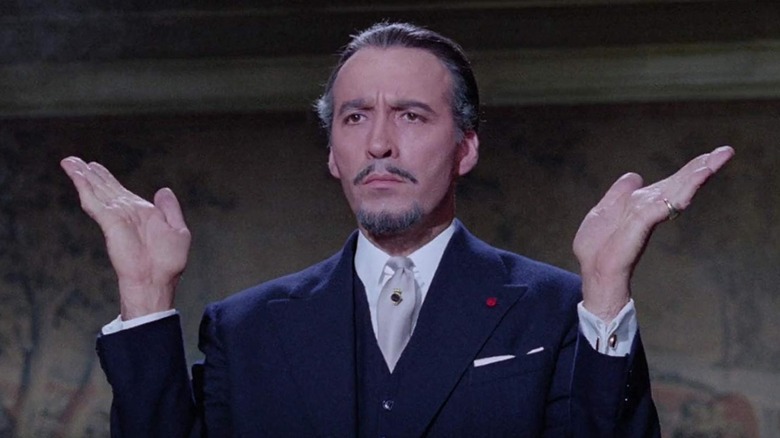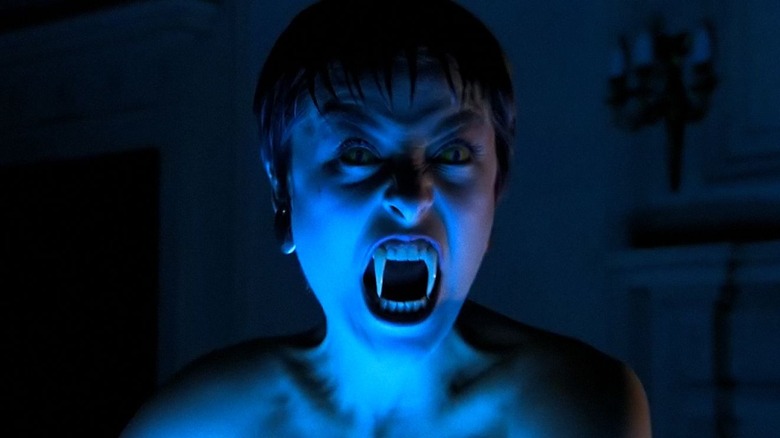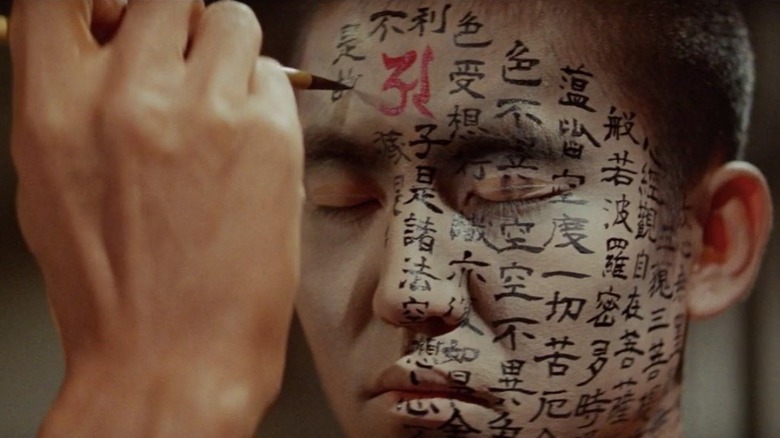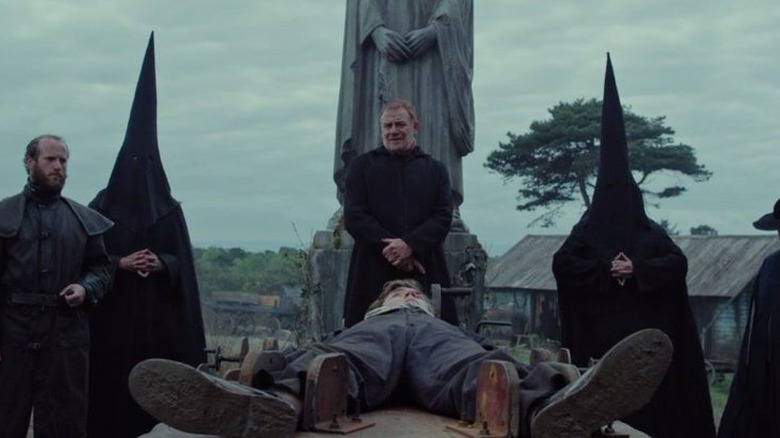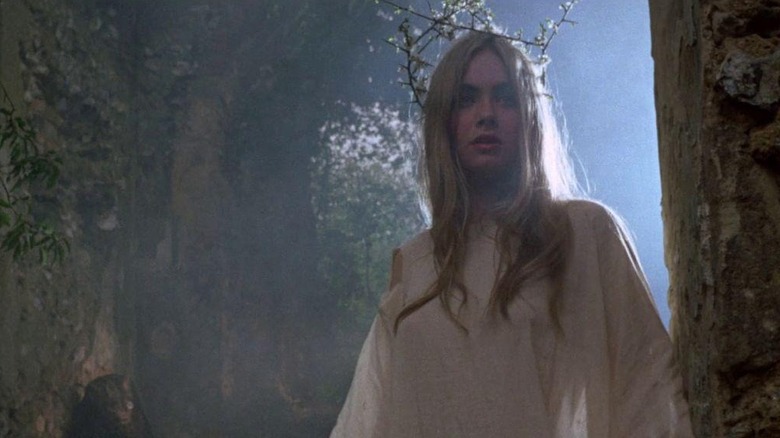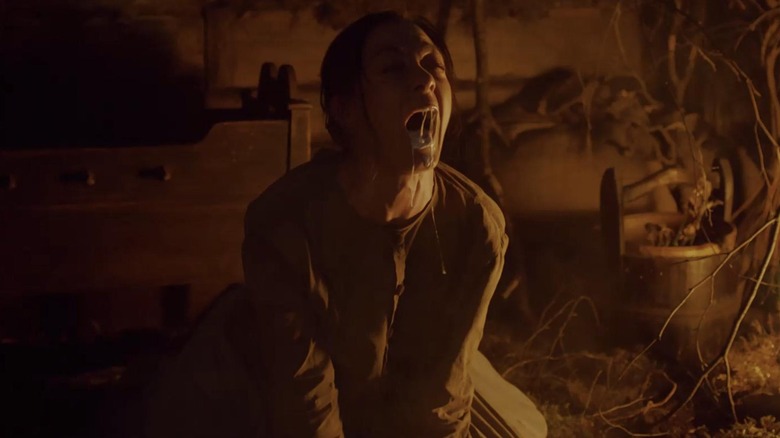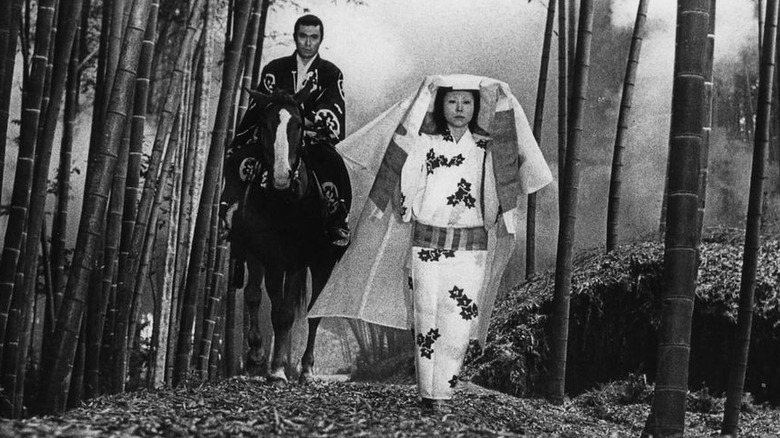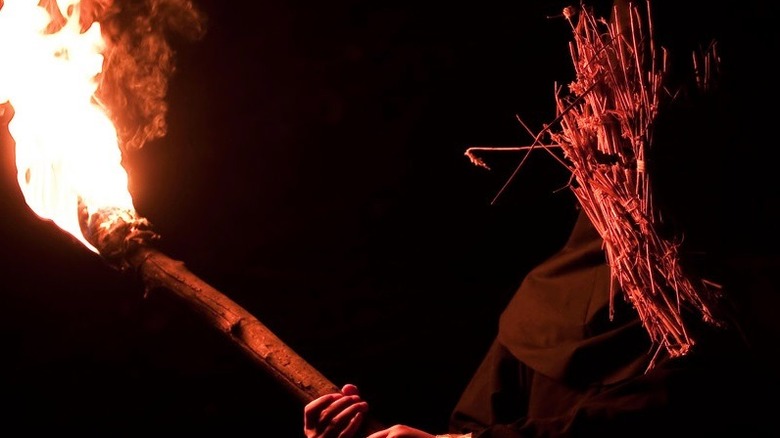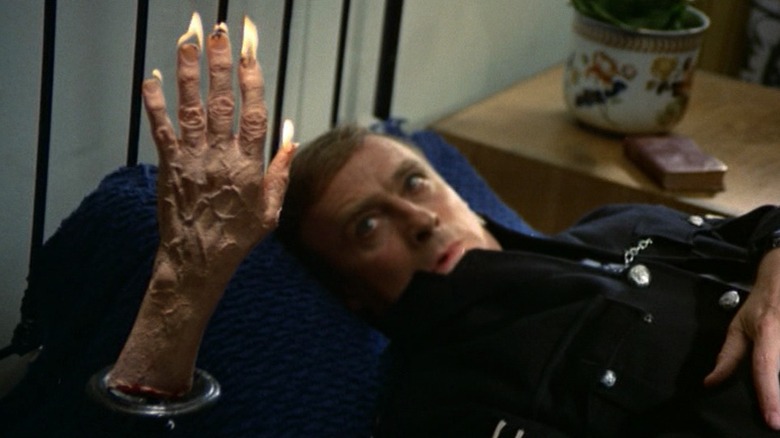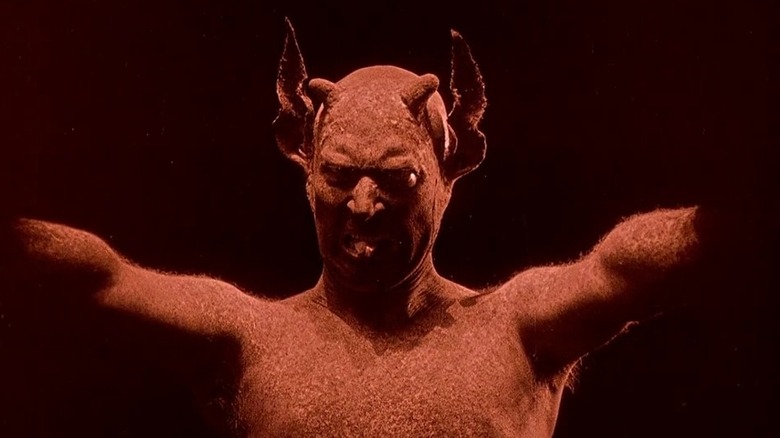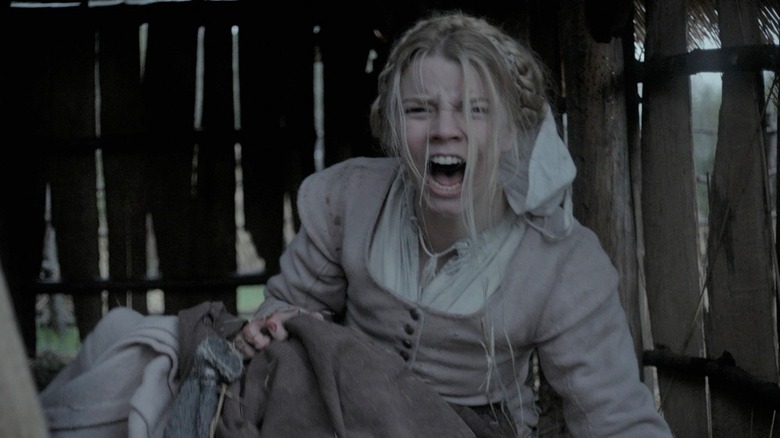The 16 Best Folk Horror Movies Of All Time
There's distant chanting in the air, toothy animal skulls dangle from nearby foliage, and the forest is unnaturally still. That impending sense of menace wafting through the trees isn't seasonal allergies — it's folk horror, one of the most unnerving sub-genres in cinema.
"Folk horror" first achieved mainstream prominence in 2010 when the BBC Four documentary "A History of Horror" used the term to describe a phenomenon of nihilistic British genre flicks that made a nightmare out of the countryside while dabbling in the occult, paganism, and ritualistic sacrifice. But, as Adam Scovell notes for the BFI, the term has since expanded to include a large swath of international spooky offerings, from silent cinema to samurai ghost stories.
Loosely defined, folk horror mines the terrifying potential of isolated rural landscapes, offering a brutal counterpoint to the romantic notion of the natural world as a restorative, tranquil paradise. In folk horror, the woods are hostile, seclusion is maddening, and the earth is riddled with the bones of the past. While not necessarily supernatural in nature, many folk horror films draw from local legends, myths, and old world beliefs. But all of them, without fail, contain an unsettling brutality — an outpouring of violence and man-made cruelty that isn't for the faint of heart. So, with that, affix your flower garlands, and let's take a look at a handful of the best films the folk horror genre has to offer.
A Field in England
Taking place in (you guessed it) a field in England, Ben Wheatley's pastoral fever dream is light on plot and heavy on an unrelenting and increasingly trippy atmosphere. Set in the throes of the English Civil War, "A Field in England” follows a handful of men who break from the warmongering herd in search of a stiff drink, only to stumble into a mystical field full of magic mushrooms and legendary buried treasure.
What follows is a literal and spiritual terror trip of depravity that provides hard proof of mankind's timeless greed. The men's delirium and increasingly absurd search for the rumored treasure turns into a visceral 17th-century purgatory — a maddening prison for wandering selfish souls. Heralded by the likes of The Guardian as "grisly and visceral" and by The Independent as "'Apocalypse Now' among the hedgerows," this isn't a film for the squeamish or for those who crave the security of logic.
Viy
The first (and only) Soviet-era horror film officially released in the USSR, "Viy" tells the story of a young priest (Leonid Kuravlyov) tasked with presiding over the corpse of a witch (Natalya Varley) for three consecutive nights, all while contending with ghosts, demons, and all manner of dark trickery as the witch attempts to escape her tomb.
Adapted from famed 19th-century author Nikolai Gogol's short story of the same name, "Viy" overtly alludes to existing Slavic folklore motifs and morality lessons (including the Russian fairy tale of "The Soldier's Midnight Watch"), while the titular Viy — a hulking, corpulent goblin king — remains a uniquely nightmarish invention of Gogol's own imagination. As dread-filled and tense as it is surreal, "Viy" is like "The Evil Dead" by way of Andrei Tarkovsky. If you've never seen a witch surf through the air on top of her own coffin, "Viy" is the film for you.
The Wailing
A mysterious sickness has stricken a small, rural village in South Korea. Those unlucky enough to catch the inflection break out in a violent rash, followed by murderous outbursts, and finally ... death. On the case is Jong-goo (Kwak Do-won), a gutless, schlubby cop whose bumbling family man persona calcifies into something more intense when things get personal. Stumbling heart-first down a dark path of fear and self-loathing, Jong-goo finds himself thrust into a world of shamanic rituals, black magic, and supernatural visitations.
Directed by Na Hong-jin, "The Wailing" is kind of like slowly suffocating for two and half hours ... but that's part of its appeal. Make no mistake, this is an absolutely crushing film, a stomach-sinking nightmare that starts off slow before spilling over into a full-on unambiguous bloodbath. Dense, twisting, and certainly living up to its name, "The Wailing" will have you guessing right until its final moments. But of course, by then, it'll be too late.
Witchfinder General
As the English Civil War ravages the countryside, the resulting chaos leaves the door open for shameless men to profit off the unchecked fears of the local peasantry. Enter Matthew Hopkins (Vincent Price), a roving, mustache-twirling masochist and self-styled witch-hunter who travels from town to town, doling out his sadistic services for a price. However, when a local soldier, wronged by Hopkins, catches on to the Witchfinder's ruse, he sets out to bring the so-called man of God to justice by whatever means necessary.
Based on Ronald Bassett's novel of the same name (and pulling from the stories of the real-life Matthew Hopkins), "Witchfinder General" flips the folk horror script by re-negotiating the true terror of superstition. The pastoral violence at the film's center isn't the result of hovel-dwelling witches or ritual Satanism but of Hopkins' exploitation of folklore itself. Why fear Satan, the film asks, when the wretched cruelties of man already exist?
November
Heralded by Rolling Stone's David Fear as "part Grimm fairy tale, part Eastern European folklore, and all fever dream," Rainer Sarnet's "November" is an absolutely unclassifiable genre offering that's as bewildering as it is beautiful. Look, this film begins with a rolling bone-robot kidnapping a cow and flying away with it like it's some kind of drone made out of an ossuary. And it only gets weirder from there!
Set in a mythical Estonian village full of death, plague, and farm tools with souls, "November" follows the local wily villagers as they resort to theft, ritual, and devilish bargains to survive the harsh winter. Meanwhile, a dark love triangle emerges between two teenagers and a sleepwalking baroness, each of whom turn to folk magic to overcome their unrequited love. With bewitching black-and-white cinematography and a bawdy medieval sense of humor, "November" is a filthy, freaky, and uncannily fun entry to any folk horror fan's watchlist. The film currently holds a critical approval rating of 96% on Rotten Tomatoes.
The Devil Rides Out
The suspiciously cult-savvy and fantastically named Duc de Richleau (Christopher Lee) and his air-headed friend, Rex (Leon Greene), are having a chummy reunion. But their little get together is one member short — Simon (Patrick Mower) is missing. When they find him at his house, he's embroiled in some very obvious, and very deadly, black magic. And thus begins the 24-hour mission to save the souls of Simon and another doe-eyed initiate named Tanith (Niké Arrighi) from the horrid clutches of a devil-worshiping cult and its charismatic leader (Charles Gray).
Adapted for the screen by Richard Matheson (of "I am Legend" and "Duel" fame), "The Devil Rides Out" is one of the last films directed by Hammer Films mainstay Terence Fisher. Boasting a 95% critical consensus on Rotten Tomatoes, the film is stuffed to the gills with occult trappings, sumptuous set pieces, and all manner of pagan goodies (including a full-on appearance from Baphomet himself).
The Lair of the White Worm
Ken Russell's eccentricities are on full display in this fantastically bananas film about an immortal pagan snake priestess turning rural England upside down. When Angus Flint (Peter Capaldi) unearths a massive snake skull in the backyard of a bed and breakfast, he believes his discovery may prove that the local legend of a giant, serpentine monster may be more fact than fiction. When the ancestor of the legendary beast's supposed slayer (Hugh Grant) corroborates his suspicion with further evidence, the pair investigate, stumbling head-first into a mystical, snake-worshipping cult overseen by their seductive and fashionable neighbor, Lady Sylvia Marsh (Amanda Donohoe).
"The Lair of the White Worm” is loosely based on Bram Stoker's 1911 novel of the same name, which was itself based on the folk legend of the Lambton Worm, a dragon who, according to myth, terrorized villagers until it was slain by a local hero. "The Lair of the White Worm” is a truly unique horror comedy with a mildly blasphemous gait, heralded by Variety as "a rollicking, terrifying, post-psychedelic headtrip."
Kwaidan
Masaki Kobayashi's stunning horror anthology is an incredible film made up of four masterpieces. "Kwaidan" offers a collection of Japanese seasonal folk tales that tell subtle, spooky, and often surreal stories of spectral armies, icy vampire women, and vengeance from beyond the grave. Trance-like both in its length and the rhythm of its storytelling, "Kwaidan" imparts a colorful, dream-like sense of unreality that sets the film firmly within the realm of myth. Meticulously crafted and rapturously stylish, demonic comeuppance is rarely this beautiful.
"Kwaidan" is based on Lafcadio Hearn's compilation of Japanese folk legends, "Kwaidan: Stories and Studies of Strange Things" (the word "kwaidan" literally translates to "ghost story”). Published in 1904 shortly before Hearn's death, the introduction to the book specifies that the stories were compiled from old Japanese texts, as well as oral histories. The tale that opens the novel, "Hoichi the Earless," is one of the most striking segments in the film. In it, a young blind priest (Katsuo Nakamura) is tricked into singing the chant of "The Tale of the Heike" for a court filled with ghosts. To save his life, his fellow priests cover every inch of his body in protective scriptures. Well ... almost every inch.
Apostle
Gareth Evans' first feature follow-up to 2016's "The Raid: Redemption" is a modern twist on an old folk horror formula — a man travels to a remote island in search of a missing girl who he believes has been kidnapped by a religious cult. But for all its family ties to the likes of 1973's "The Wicker Man," "Apostle" is its own bloody mess, a 19th-century cult-infiltration tale that curdles into something much more otherworldly and supernatural.
A twisty genre-hybrid pulled in a couple different directions, "Apostle" is neither a conventional action film nor the typical slow-paced fare that folk horror fans have come to expect. "Apostle" oscillates from atmospheric scene-setting to gnarly gore-filled delights sure to satisfy the pickiest bloodhound. With killer performances by Dan Stevens as our intrepid, overwhelmed hero and Michael Sheen as the island community's charismatic cult leader, "Apostle" is dead-on proof that more action directors should venture out into the horror genre.
The Blood on Satan's Claw
A misshapen and fetid corpse is accidentally exhumed in the farmland of 18th-century England, and soon, superstitious anxieties begin gripping the countryside. The mounting paranoia encourages the local children to start playing diabolic games in a crumbling church. Under the de facto leadership of the inappropriately named Angel Blake (Linda Hayden), the children become convinced the corpse was once possessed, and they use the rotting body to conduct all manner of depraved rituals. After all, few things are scarier than peer pressure, but a stern judge (Patrick Wymark) takes it upon himself to halt the corrupting demonic influence and restore order to the fracturing community.
Children shouldn't play with dead things, and they certainly shouldn't joke around with ritualistic human sacrifice. And you cannot talk about "folk horror" without talking about "The Blood on Satan's Claw." No. Literally. The film's director, Piers Haggard, coined the sub-genre's moniker in a 2003 interview with Fangoria. Visually lush and viscerally shocking in its satanic debauchery, "The Blood on Satan's Claw" is much more than a historical curio. Melding slow-burning pacing with the alarming brutality of exploitation cinema, "The Blood on Satan's Claw" is an absolute must for fans of the sub-genre.
Hagazussa: A Heathen's Curse
Forest-dwelling witches tend to be the villains of folk horror. But Lukas Feigelfeld's debut feature tells a different tale. "Hagazussa" is all about the horror of being the kind of person that folk legends might brand a witch, the kind of fringe outsider on the unfortunate receiving end of superstition. Set in the Austrian alps during the 15th century, "Hagazussa" follows Albrun (Aleksandra Cwen), a reclusive single mother whose particularity and unabashed strangeness invites mean-spirited sideways glances and outright violence from the fearful townsfolk. Backed up into a corner, the film charts the terrifying shape of an unwell mind pushed to its breaking point.
Patiently paced, stomach-churning, and visually sumptuous, "Hagazussa" is one of the most poetic, underseen, and utterly devastating horror offerings of the 2010s. An empathetic and unrelenting portrait of the dark side of superstition, "Hagazussa" is a dreamy, magic mushroom-fueled nightmare and an essential watch for all folk horror aficionados.
Kuroneko
Directed by the master craftsman Kaneto Shindô, "Kuroneko" is a Heian-period ghost story about love, loss, and cat-like demon women ripping the throats out of errant samurai. When a decorated war hero (Kichiemon Nakamura) is sent to locate and destroy the fearsome presence dispatching his fellow soldiers, he winds up face to face with his own demons and the life he left in the dust when he took up the sword. With an eerie, dream-like atmosphere exquisitely realized by co-cinematographers Norimichi Igawa and Kiyomi Kuroda, "Kuroneko" is a gorgeously haunting spectral encounter in and of itself.
"Kuroneko" evokes supernatural, shapeshifting cats like the bakeneko, as well as Japanese folk stories about onryo, vengeful spirits abused in life, whose posthumous fury cannot be contained in death. With a shocking feminist thesis and a commanding sense of grief, "Kuroneko" boasts a 95% on Rotten Tomatoes and has been heralded by Criterion as a landmark of Japanese horror history.
Kill List
Directed by Ben Wheatley, "Kill List" is the kind of movie you never, ever, want to watch a second time. And we mean that as a good thing. Prodding diabolically into pagan histories while keenly aware of contemporary British genre conventions, "Kill List" blurs the line between brutally naturalistic mercenary violence and belief-based ritual with horrifying results.
The film follows two former soldiers turned hitmen (Neil Maskell and Michael Smiley). It's been one year since a botched job in Kyiv, and the pair are desperate for work. Approached by a mysterious client, the deadly duo are presented with a seemingly lucrative assignment — three killings for a large sum. What follows is an increasingly labyrinthian nightmare of conspiracies and coincidences that will keep you guessing until the film's absolutely brutal final act. Widely hailed as one of the best horror films of the 21st century, "Kill List" is as sadistic as its main characters. You've been warned.
The Wicker Man
A key pillar of the unholy trinity of British folk horror films (along with "Witchfinder General" and "The Blood on Satan's Claw"), Robin Hardy's "The Wicker Man" is, quite simply, one of the best examples of what the sub-genre has to offer. The film's protagonist is a righteous, tight-lipped police officer named Neil Howie (Edward Woodward), who arrives on Summerisle in search of a missing child. Summoned to the remote island by an anonymous and cryptic letter, Sergeant Howie's initial shock at the locals' bizarre pagan traditions slowly twists into frustration and ultimately outright fear as the islanders insist the missing girl never even existed.
Like the best of its kind, "The Wicker Man" is a slow burn until it isn't — until all its steadily mounting intensity boils over into the horrid realization that Sergeant Howie never stood a chance. But your chances of survival are always slim when Christopher Lee is stalking about as a devilishly calm cult leader. Oh, and did we mention that "The Wicker Man" is a musical? Because it is.
Häxan
Benjamin Christensen's monumental silent film isn't just unlike any film on this list ... it doesn't compare to anything else in the history of cinema. Part historical re-enactment, part gothic horror film, part video essay, "Häxan" strings together a series of dramatized vignettes to explore the hypothesis that there's a link between medieval witchcraft and undiagnosed mental illness. Split into four parts, the film is anything but stodgy and academic, diving head-first into the satanic annals of history to tease out the powerful influence of superstition. Filled with torture, nudity, and all manner of deviancy, "Häxan" offers an unflinching portrait of the fervor-fueled atrocities visited upon women accused of witchcraft while deviously blending fact and fiction.
A valuable history lesson and a legitimate horror show, "Häxan" is regarded by critics and scholars as Christensen's masterpiece, with the film sporting a 91% on Rotten Tomatoes. The 2013 edition of "1001 Movies You Must See Before You Die" describes "Häxan" as "truly a unique work that still holds power to unnerve, even in today's jaded era".
The Witch
When William (Ralph Ineson) defies the local church, he and his family are banished to the rural fringe of New England, where the impassable landscape and the creeping isolation begin to take their toll. The family's crops fail without reason, and their newborn son vanishes without a trace. Eaten away by hunger and paranoia, blame repeatedly rests on their oldest daughter, Thomasin (Anya Taylor-Joy), who was minding the infant when he disappeared. When Thomasin's younger siblings accuse her of witchcraft, the family's mounting, inexplicable tragedies become the devilish work of a teenage girl, with Thomasin backed up into a hellish corner by her own flesh and blood.
While Robert Eggers' meticulous and richly atmospheric debut is often heralded as a slow burn, "The Witch" doesn't so much simmer as bubble up right before your eyes, escalating from rural exile to ritual child murder before you can catch your breath. And as the repressive bind of her parents' faith begins to loosen, you can hardly blame Thomasin for her unwillingness to go quietly as the family's scapegoat.
Heralded by Time as "a triumph of tone," "The Witch" was awarded the Golden Tomato award as the best-reviewed horror film of 2016. Earning its place among the all-time great horror films, "The Witch" is a delicious slice of superstitious paranoia that confidently blends fearsome fantasy and historical nightmare.
